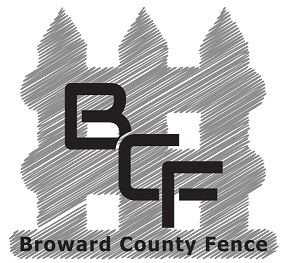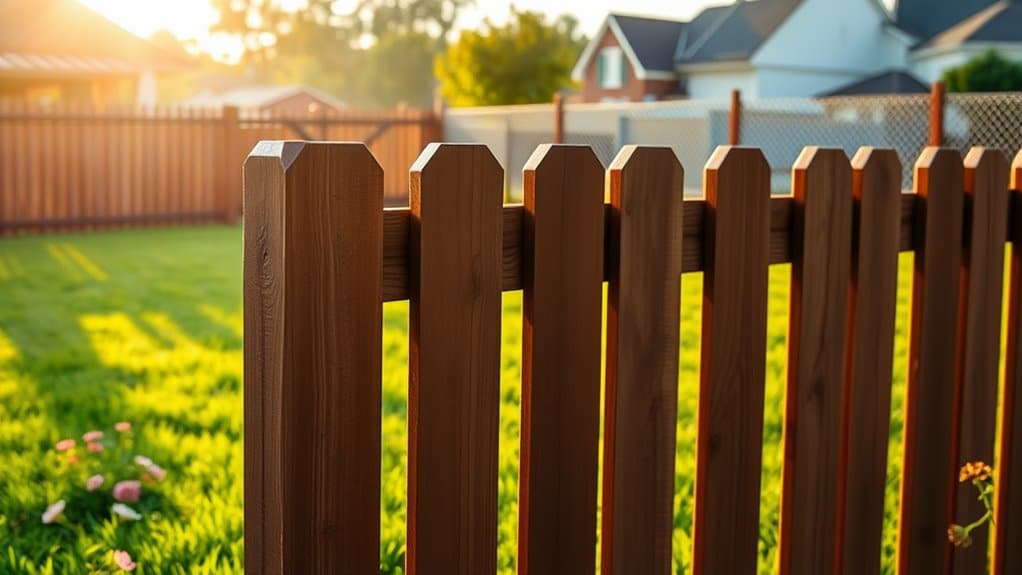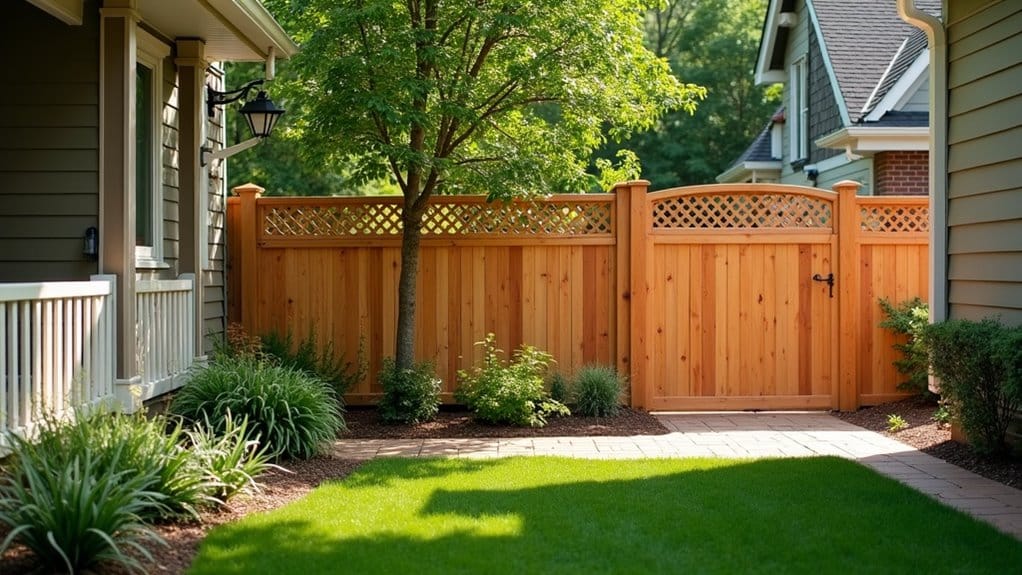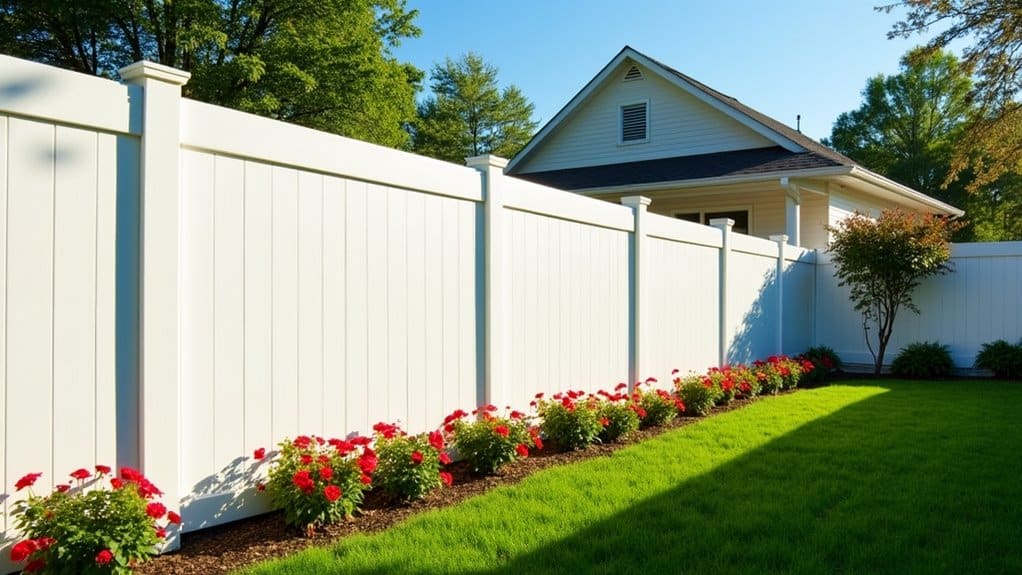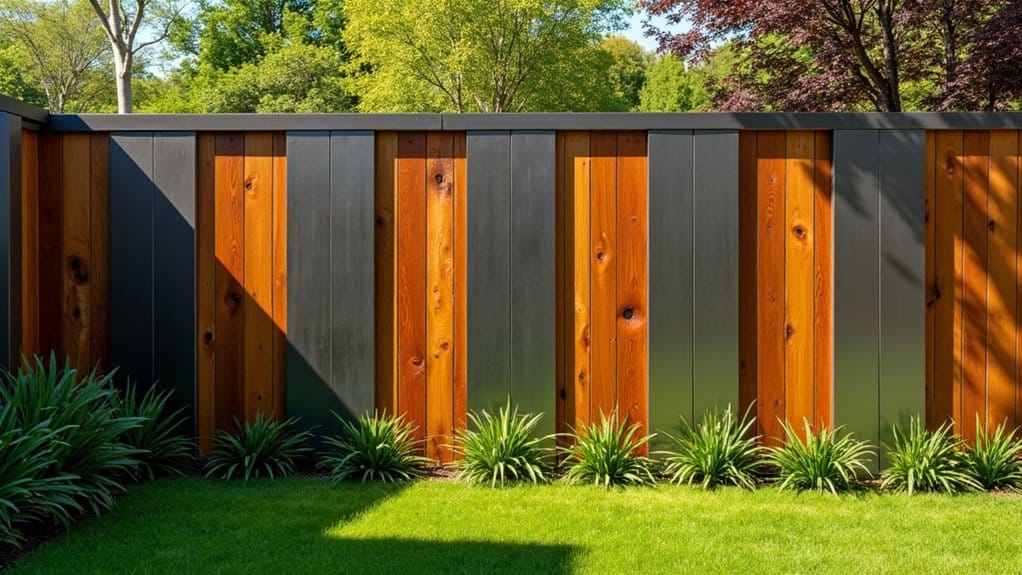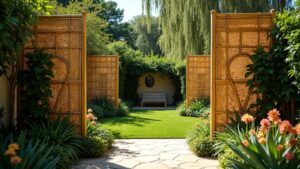When planning for residential fencing, it's crucial to understand the costs involved. On average, you can expect to spend around $1,800, but prices may vary from $1,500 to over $3,000 based on factors like material, length, and installation challenges. For example, wood fencing costs between $10 and $45 per linear foot, while vinyl ranges from $14 to $32. Labor can add approximately $1,600, with more complex installations increasing this rate. Maintenance costs also differ by material, affecting your long-term expenses. By considering these factors, you'll have a clearer idea of your budget. Read on for more details about specific materials and tips to save costs.
Key Takeaways
Residential fencing typically costs between $1,500 and $3,000, depending on the materials and installation details.
Material choice affects pricing: wood fences range from $10 to $45 per linear foot, while vinyl costs between $14 and $32. Labor usually accounts for about 50% of the total cost, averaging around $1,600 for installation.
Additional expenses can include site preparation, removing an old fence, and permits, which can impact your overall budget.
Maintenance costs also differ by material. Wood requires $200 to $500 annually, whereas vinyl and aluminum are lower, needing about $100 to $200 for upkeep.
Overview of Fencing Costs
When planning a residential fence, understanding costs is crucial. Key factors include the type of material, length, height, terrain, and labor.
For example, chain-link fencing is budget-friendly at $10-$20 per linear foot, while vinyl and metal options can start at $40 or more. If your yard is sloped or has obstacles, expect extra costs for specialized installation. Longer fences require more posts, which can significantly increase both material and labor costs. Additionally, contractor experience can play a significant role in the overall installation cost.
Maintenance varies by material, affecting long-term expenses. Labor costs can increase for complex installations or when removing an old fence.
If upfront costs are a concern, consider financing options. Many contractors can also guide you through local zoning regulations to ensure compliance.
To save money, choose cost-effective materials, scale down your project, and get multiple quotes from contractors. If you're handy, DIY installation can significantly lower labor costs, making the project more affordable.
National Average and Cost Range
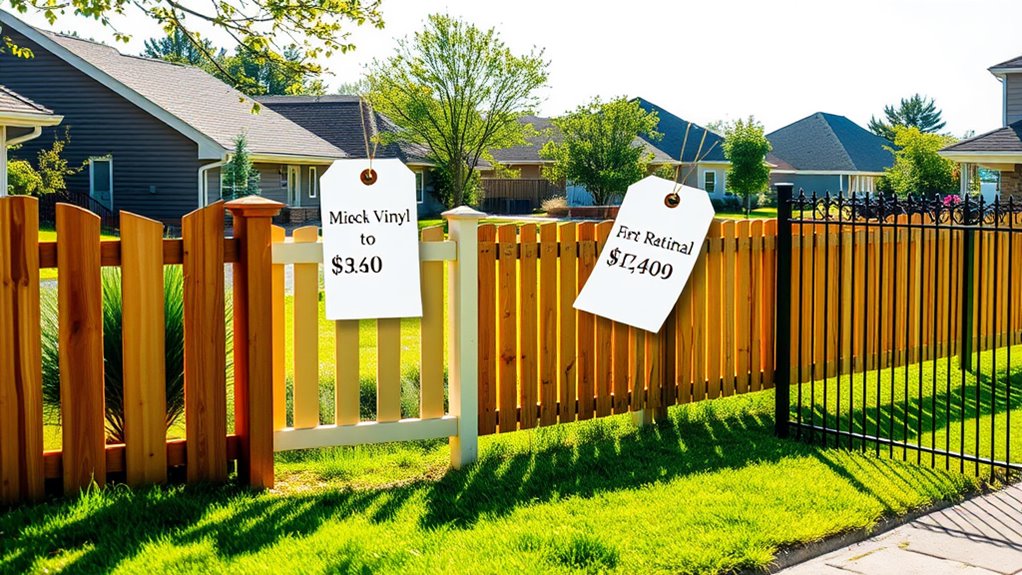
Knowing the national average and cost range for residential fencing is essential for budgeting your project. The average cost for fencing an average yard is around $1,800, with typical costs between $1,500 and $3,000.
However, prices can vary significantly, starting as low as $200 and going up to $6,600. The type of fencing material you choose greatly affects your total cost. For example, wire fencing might cost about $1 per linear foot, while wood fencing ranges from $10 to $45 per linear foot. Additionally, vinyl fencing is an affordable and durable alternative to wood, providing a long-lasting option for many homeowners.
Other materials like vinyl and aluminum also have different price points, which can impact your design choices. Fencing costs can range from $1,500 to $3,000 on average, depending on the material selected.
Factors such as the length and height of the fence, along with the complexity of your yard, will influence both the installation time and final cost. Generally, longer and taller fences require more materials and labor.
Don't forget to consider any grading or obstacles that may increase labor expenses. Understanding these costs will help you make smarter decisions for your fencing project.
Cost Per Linear Foot
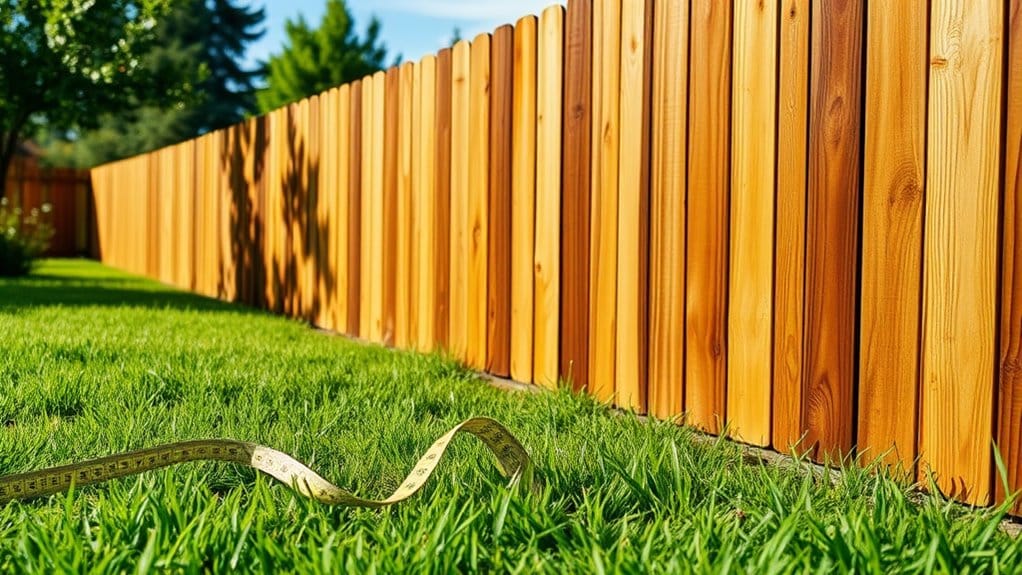
When planning your fencing project, understanding the cost per linear foot is crucial for your budget. Prices vary based on material, height, and installation complexity.
For example, aluminum fencing ranges from $17 to $90 per linear foot, while chain-link is more budget-friendly at $8 to $40. Additionally, considering weather resilience can help you select a material that lasts longer and requires less maintenance.
Your total cost will depend on the linear footage required. For a 1/4-acre lot, you might spend around $4,850 to cover approximately 220 linear feet. Labor costs can significantly impact the final price, particularly for complicated installations with slopes or corners.
Staying informed about local regulations and design trends can also guide your decisions, affecting both aesthetics and cost.
Types of Fencing Materials
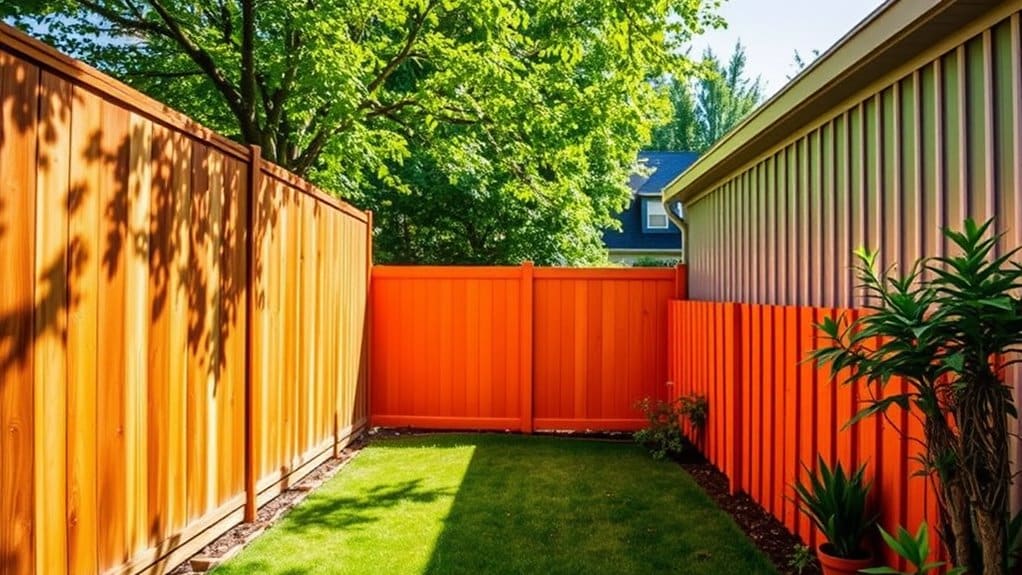
When selecting a fencing material, consider cost, durability, and maintenance. Options like wood, metal, and synthetic materials each have their advantages. For instance, wood offers a classic look but requires regular upkeep, while metal is sturdy and low-maintenance. Understanding these factors will help you choose the best fence for your needs and budget. Additionally, vinyl is very durable and resistant to fading, making it a great option for those seeking longevity without high maintenance. Moreover, vinyl fencing provides a wide range of styles that can be customized to blend seamlessly with your home and landscape.
Cost Comparison by Material
- Wood: Typically costs between $10 and $30 per linear foot. It offers a classic look but requires maintenance for longevity, as wood fencing typically holds a higher resale value compared to PVC options.
- Metal: Wrought iron starts at $55 per linear foot, while aluminum and steel range from $24 to $45. These materials are durable and modern but may need rust protection.
- Synthetic: Vinyl prices range from $14 to $32 per linear foot and require little maintenance. Composite materials mimic wood's appearance and last over 20 years, costing between $23 and $37. Additionally, selecting cost-effective materials can help keep your overall fencing project within budget.
Understanding these costs can help you choose a fence that fits your budget and aesthetic needs.
Durability and Maintenance Factors
When choosing a fencing material for your property, consider durability and maintenance. Different materials have different lifespans and upkeep needs.
For example, aluminum fencing can last 20 to 30 years with little maintenance, as it resists rust and pests. Vinyl fencing, which is also resistant to rot and insects, can last up to 20 years and only needs occasional cleaning. Additionally, aluminum fencing is the most durable option available, making it a wise investment for long-term use.
On the other hand, chain link fencing lasts around 15 years but requires regular rust treatment and timely repairs. Wood fencing offers a classic look but is less durable, lasting 10 to 20 years and needing regular sealing and staining to prevent damage.
By understanding these durability factors, you can create a maintenance schedule that fits your chosen material.
Opting for low-maintenance, long-lasting materials can save you time and money while keeping your fencing attractive and functional.
Make an informed choice for lasting value and ease of upkeep.
Aesthetic Appeal Considerations
Fencing is key to your property's aesthetic, and choosing the right material can boost your home's curb appeal.
Here are three popular options:
- Wood Fencing: With its classic charm, wood fences can be customized in height and finish to complement your home's style.
- Metal Fencing: For a modern touch, metal options like aluminum or wrought iron offer sophistication and versatility, fitting various designs. Additionally, metal fencing is highly durable, resistant to rot, decay, and insect damage, ensuring longevity.
- Vinyl Fencing: This low-maintenance option provides a contemporary look and can mimic wood, making it a cost-effective choice in the long run.
Each material has its unique appeal, allowing you to enhance your property's beauty while aligning with your aesthetic preferences and lifestyle.
Labor Costs and Considerations
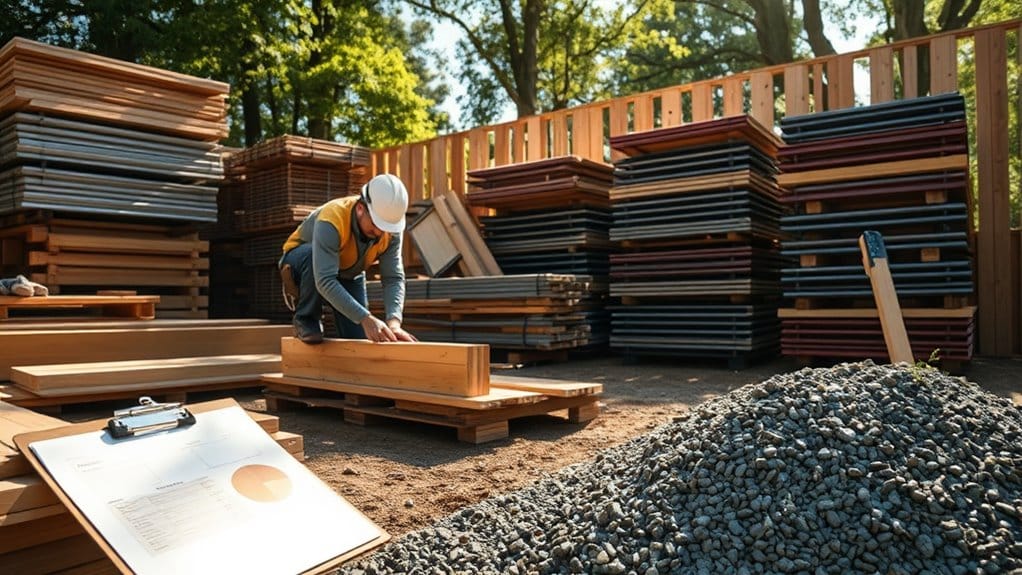
When planning your fence installation, understanding labor costs is crucial for staying within budget. Labor rates typically range from $30 to $100 per hour, influenced by your region's cost of living. Expect to pay between $13 and $20 per linear foot for labor, with experienced contractors charging more. Labor can make up about 50% of your total project costs, which averages around $1,600. Complex projects, like those on sloped land or with custom designs, will increase labor expenses. Additionally, site conditions like debris or rocks can significantly raise the labor costs due to increased digging challenges.
If you consider a DIY approach, you could save about $1,700 in labor costs, but mistakes can be costly. Hiring a professional can save you time and ensure compliance with local regulations, benefiting your budget in the long run. Don't forget to account for any additional work, like stump removal or land leveling, as these can also impact labor costs.
Factors Influencing Overall Costs
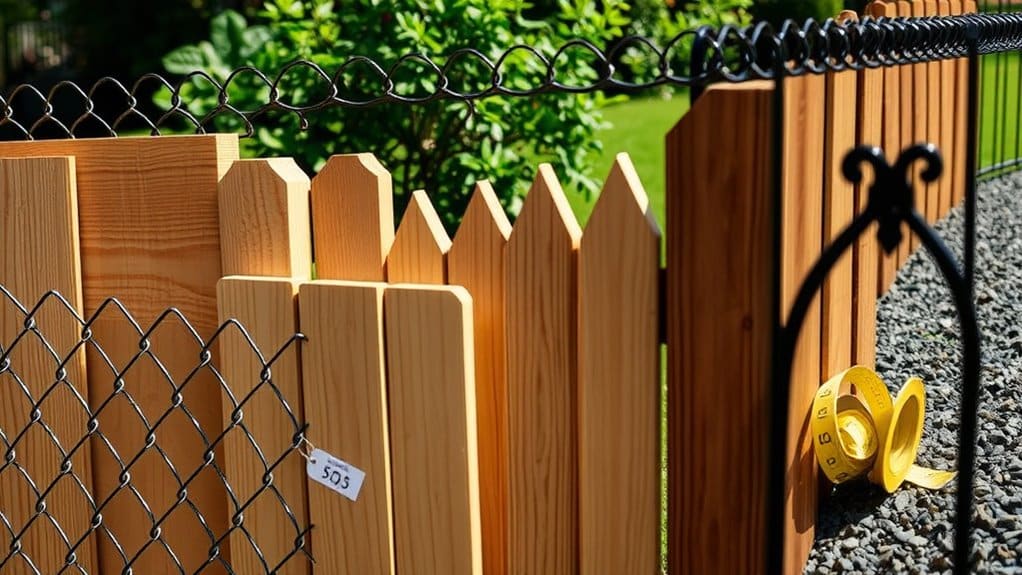
When planning to install a fence, a few key factors will affect your overall costs.
The material you select—like wood, vinyl, or chain link—can vary widely in price. Material choices significantly influence both the initial cost and long-term durability of your fence.
The complexity of the installation, such as whether your yard is flat or hilly, also impacts labor costs.
Additionally, the size of your property will determine how much material you need.
Material Selection Impact
Choosing the right material for your fence can significantly influence your budget. Here's what to consider:
- Material Sustainability: Eco-friendly options like vinyl might cost more upfront, but their durability means you'll replace them less often and save on maintenance. Additionally, installation costs for vinyl can vary, typically ranging from USD$20 to USD$45 per linear foot.
- Design Versatility: Wood fences come in various styles, which allows for customization. However, they require regular upkeep to prevent damage, which can be time-consuming and costly.
- Durability and Maintenance Costs: Vinyl and metal fences are durable and low-maintenance, which can save you money in the long run. Wood, on the other hand, often needs more frequent care to avoid rot and wear, adding to overall expenses.
Labor Complexity Considerations
Labor complexity significantly affects the cost of your fence installation. The experience level of laborers plays a crucial role; while skilled installers may charge more, their expertise often leads to faster and more efficient work.
The terrain of your yard also impacts labor costs. If your ground is sloped or uneven, expect to pay more due to the need for extra groundwork and specialized techniques. Obstacles like rocks or roots can further complicate the installation, increasing labor hours and expenses.
Removing an old fence will add to your labor costs as well. Although DIY might seem like a way to save money, it requires skill, time, and the right tools. Hiring a professional may be pricier initially, but it typically results in a quicker and more reliable installation.
Property Size Variations
When planning your fencing project, property size is a key factor that affects costs significantly. Here's how:
- Material Needs: Bigger properties require more fencing. For every additional 100 feet, you could spend about $2,500.
- Terrain Challenges: Hilly or uneven terrain can increase both material and labor costs.
- Fencing Aesthetics: The size of your property can influence the visual appeal of your fence, depending on the layout and style you choose.
For instance, fencing a one-acre lot can average around $23,350, while a quarter-acre lot may only cost about $5,840.
To avoid surprises, it's crucial to measure your property boundaries accurately, ensuring your fencing project is both functional and attractive.
Additional Costs to Consider
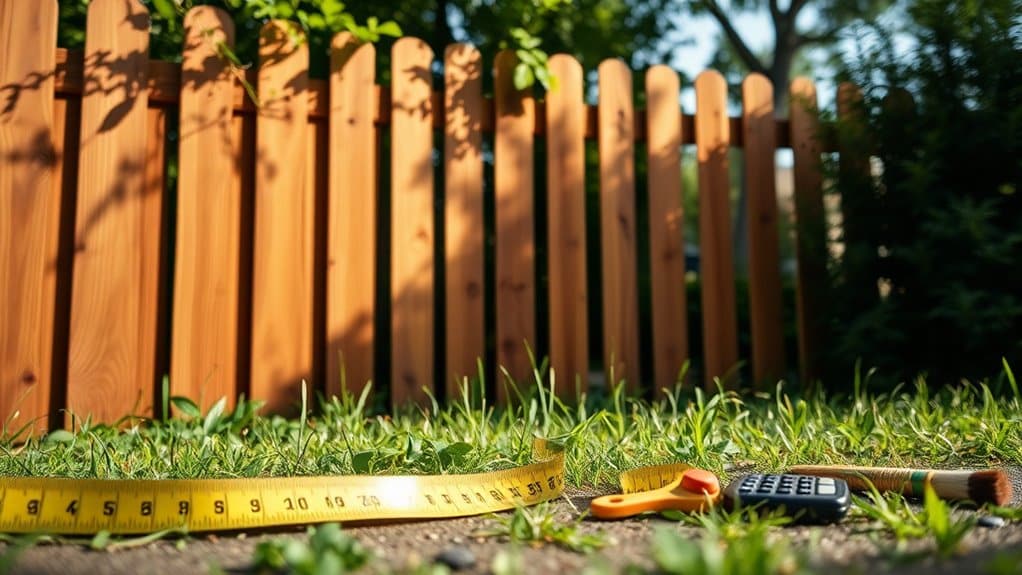
When planning your residential fencing project, it's crucial to consider additional costs that can affect your budget.
First, land grading and preparation can run between $50 to $200 per hour. This step ensures your fence is level and secure but may extend your project timeline and increase labor costs for debris removal.
If you have an existing fence, removal costs can range from $350 to $600 per linear foot. While you can save on labor by removing it yourself, you'll need to handle disposal properly.
Don't overlook permits and inspections, which vary by location and can delay your project if not obtained beforehand. These fees are necessary for complying with local regulations.
Lastly, factor in maintenance costs, which can vary significantly based on the material you choose. For example, wood fences require regular upkeep.
Budgeting for these expenses is essential to avoid surprises later on. If you're considering financing, also look into installation warranties for added peace of mind.
Fencing for Large Properties
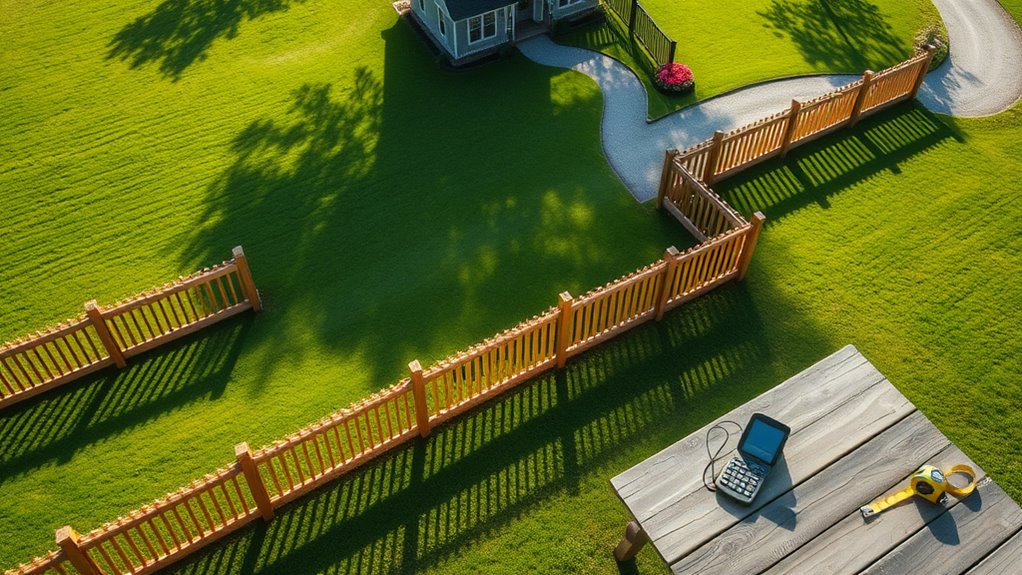
When fencing a large property, it's crucial to understand costs per acre for budgeting.
Material choice significantly affects expenses, and installation can be tricky depending on the terrain.
For instance, fencing a flat field will be easier and cheaper than a hilly area.
Consider these factors carefully to choose the best option for your property.
Cost by Acreage
Fencing a large property can be a major investment, with costs varying based on acreage. Here's a quick overview:
- ¼ acre: $5,840 to $10,200
- 1 acre: $19,500 to $23,350
- 5 acres: Around $43,000
Several factors affect these costs. Taller fences need more materials and labor, and irregularly shaped properties may require additional fencing compared to standard rectangular ones, increasing expenses.
Installation permits can also add to your budget, especially if local authorities or HOAs are involved.
Lastly, if you opt for decorative elements, keep in mind that they can enhance your property's appeal but will also raise costs.
Make sure to measure your property accurately to get the best estimate. By considering these factors, you can better manage the costs of your fencing project.
Material Impact Analysis
Choosing the right materials for your fencing project is crucial for both cost and satisfaction, especially for larger properties. Steel and aluminum are excellent choices due to their durability and low maintenance, though they come with higher upfront costs of $17 to $90 per linear foot. Their long lifespan can make them worth the investment.
For a budget-friendly option, chain-link fences are practical and cost-effective, priced between $8 and $40 per linear foot. They offer good security without a hefty price tag.
If aesthetics matter, wood fences add charm but require regular upkeep, which mightn't be ideal for larger areas.
Consider eco-friendly materials like vinyl and composite fencing, which are durable and require minimal maintenance. Vinyl costs between $20 and $40 per linear foot, while composite ranges from $11 to $45. These choices not only support sustainability but can also boost your property's value.
In the end, balancing durability, maintenance, and appearance will help you make the best decision for your fencing needs.
Installation Challenges Faced
Installing a fence on a large property can be challenging and requires careful planning. Here are three key issues to consider:
1. Obstacles: You may face tree roots, rocky soil, or underground utilities that complicate digging post holes.
While specialized equipment can help, it also increases labor demands.
2. Alignment: Keeping the fence straight over long distances is essential.
Misalignment can lead to visual and functional problems, especially at corners and gate posts that experience more stress.
3. Weather: Weather conditions can delay installation and affect material durability.
Rain or extreme temperatures might lead to issues like leaning posts or sagging gates, requiring more maintenance over time.
Material-Specific Pricing Insights
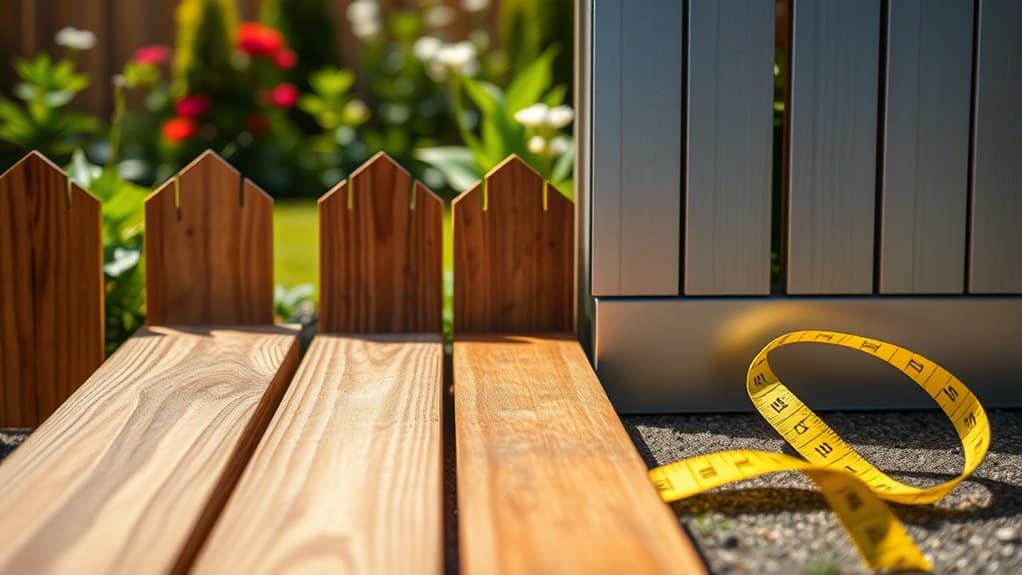
Choosing the right fence for your property requires an understanding of material-specific pricing, as costs can vary significantly.
For example, aluminum fencing ranges from $17 to $90 per linear foot, while chain-link fencing is more budget-friendly at $8 to $40 per linear foot.
If you're looking for a good balance of cost and aesthetics, composite fencing is priced between $11 and $45 per linear foot.
Vinyl fencing is durable and visually appealing, costing between $15 and $60 per linear foot, while wood fencing offers a classic look but needs more maintenance, with prices around $10 to $45 per linear foot.
For those on a tight budget, barbed wire and hog wire are very economical, costing as little as $0.75 to $3.25 per linear foot.
Keep in mind that your choice will impact both your initial costs and the long-term maintenance of your property.
Long-Term Maintenance Expenses
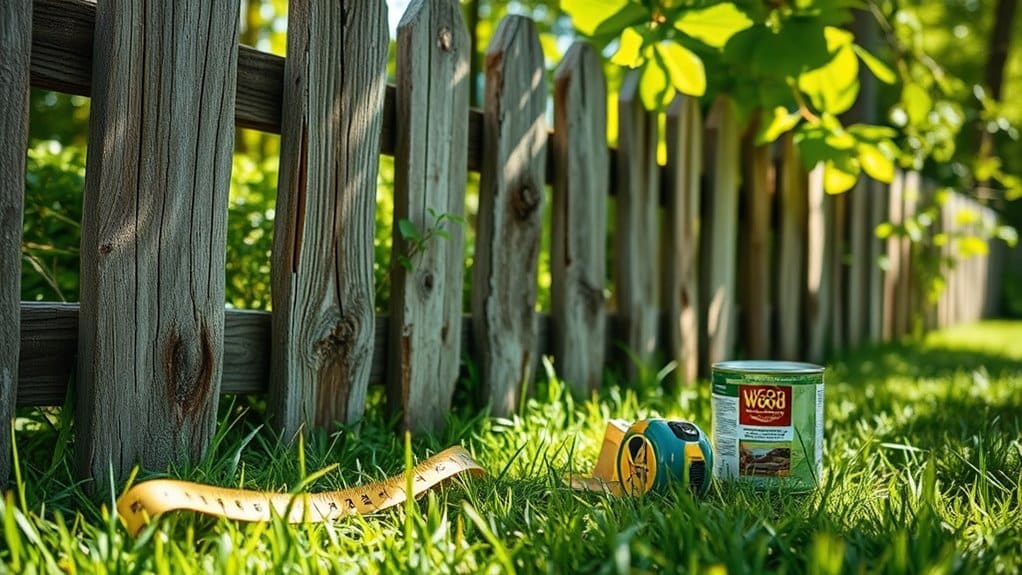
When considering fencing materials, it's crucial to factor in long-term maintenance costs, as they can significantly affect your overall investment.
Here's a quick overview of what you can expect:
- Wood Fences: Maintenance costs range from $200 to $500 annually. You'll need to stain or paint them every few years. They last about 10-15 years, but poor upkeep can lead to premature replacement.
- Vinyl Fences: These cost roughly $100 to $200 each year, requiring just occasional soap and water cleaning. With a lifespan of 20-30 years, they're a great low-maintenance choice.
- Chain Link and Aluminum Fences: Maintenance costs for these are generally lower than wood and similar to vinyl. Regular checks for rust and sagging are essential. Expect chain link to last 15-20 years and aluminum 20-30 years.
Choosing the right fence involves understanding both initial costs and ongoing maintenance to make the best decision for your needs.
Frequently Asked Questions
How Do I Choose the Right Fencing Material for My Needs?
To choose the right fencing material, focus on what matters most to you. Consider the style you want and how much time you can dedicate to maintenance. For example, vinyl is durable and requires little upkeep, making it a great low-maintenance choice. On the other hand, wood offers a classic, natural look but needs regular care, like staining or sealing. Think about your priorities to find the best fit for your needs.
Can I Install the Fence Myself to Save Costs?
Installing a fence yourself can save you money. Just like any DIY project, it requires careful planning and consideration of your skills and time. While you can find cost-saving tips, think about the potential for mistakes and delays. If you're confident in your abilities and have the time, go for it!
What Is the Lifespan of Different Fencing Materials?
When comparing fencing durability, wood typically lasts between 4 to 30 years, depending on the type and treatment. In contrast, vinyl and composite fences usually last over 20 years. Wood requires regular maintenance, like staining or sealing, while vinyl and composite need very little upkeep, making them more practical options for busy homeowners.
Are There Eco-Friendly Fencing Options Available?
Yes, there are eco-friendly fencing options! Look into materials like bamboo, composite lumber, and recycled plastic. These choices are sustainable, reduce waste, and are durable, making them great investments for your property.
How Do Local Regulations Affect Fencing Installation and Costs?
Local regulations can seem daunting for fencing projects, but they can actually simplify the process. For example, knowing your zoning laws helps you determine where you can place your fence and what materials are allowed. Securing the right permits beforehand prevents delays and avoids fines, making your installation smoother. In short, following local rules can save you time and money in the long run.
Conclusion
When it comes to fencing your property, understanding the costs and options is essential. Choosing the right materials can enhance your yard, whether you want security or a peaceful retreat. Remember, investing in quality fencing adds value to your home. Let's explore how to create an outdoor space that you and your neighbors will appreciate!
